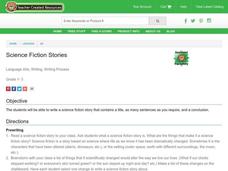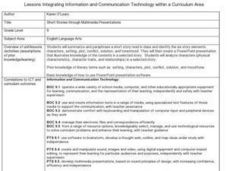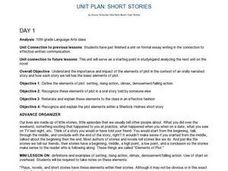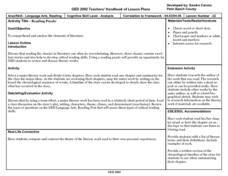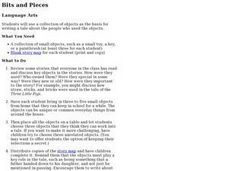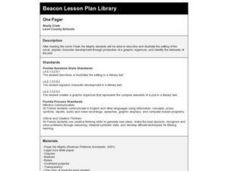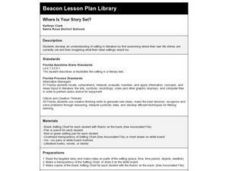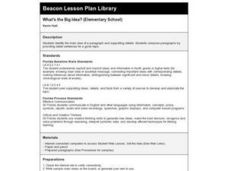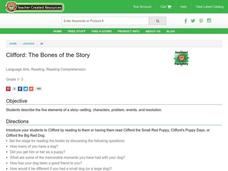Curated OER
Cooperative Learning Groups Cooperate
Students apply Bloom's Taxonomy to reading selections. They prepare questions for each level of Bloom's Taxonomy and exchange them with other groups to answer. They answer another group's questions and report to one another.
Curated OER
Building Two Literature Pyramids
Students create literature pyramids. They read selections of various societies, eras, and ideas. They complete two pyramid sheets for the same literary element including either plot, character, setting, or theme. They color-code their...
Curated OER
Building a Literature Pyramid
Students create a literature pyramid. They review and discuss their assessment task and rubric and select the literature for their pyramid. They read the literary selection and complete a pyramid sheet for one of the four literary...
Curated OER
Story Map Situations
Third graders explore a variety of ways to represent text. They represent text in story maps while on the playground. Students depict the elements of a story on a story map. They create a poster for character, setting, problem, and the...
Curated OER
Science Fiction Stories
Students review the story writing process and the elements such as prewriting, drafting, editing, revising, publishing, and assessment. Next students write a science fiction story that contains a title, the requested number of...
Curated OER
Short Stories Through Multimedia Presentations
Ninth graders summarize and paraphrase a short story read in class. They identify the six story elements of character, setting, plot, conflict, solution, and tone/mood. Students create a PowePoint presentation that illustrates the...
Curated OER
Unit Plan: Short Stories
Tenth graders complete a unit of lessons on the story elements of Sherlock Holmes short stories. They analyze the plot elements, complete graphic organizers, read and discuss the plots, observe a person and take notes, and analyze an...
Curated OER
Reading Puzzle
Twelfth graders examine the elements of literature. They each read a chapter of a novel, sequentially list the main ideas, present a summary of the chapter to the class, sequence the events, and review the novel by summarizing the timeline.
Curated OER
The Mysteries of Harris Burdick
Fourth graders read and discuss the book, The Mysteries of Harris Burdick. They create an original story that follows the Harris Burdick formula, and illustrate the story in the style of Chris VanAllsberg.
Curated OER
Bits and Pieces!
Students discuss story elements including characters, setting, problem and solution. They listen to the story, Winter Fun, and identify the story elements. Then they draw pictures and write one sentence for each story element.
Curated OER
Let's Watch a Story
Fourth graders watch a silent movie and identify the elements of a story. They complete a worksheet attached to the lesson and discuss their answers.
Curated OER
Let's Retell This Story
Fourth graders identify story grammar elements of "The Three Billy Goats Gruff." The elements are recorded on a chart and students use the story grammar elements from the chart to retell the story.
Curated OER
One Pager
Young scholars read the novel, Freak the Mighty and describe and illustrate the setting. They create a graphic organizer that demonstrates the major plot elements and character development.
Curated OER
Novel Analysis
Learners read the novel, Lord of the Flies, then write an essay analyzing the novel. They analyze, in small groups, characters, plot, setting, style, symbolism, theme, critical responses, and historical influences
Curated OER
Where Is Your Story Set?
Students explore the concept of setting in literature by identifying their own current setting, and imagining what their ideal setting would be. They read a piece of literature, identify the setting and record the information on a chart.
Curated OER
What's the Big Idea?
Students choose a paragraph from a book of their choice, identify the main idea, and draw an illustration of the main idea. They write original paragraphs, illustrate them, and trade with a partner, identifying the main idea of the...
Curated OER
The Bones of the Story
Students describe the five elements of a story--setting, characters, problem, events, and resolution. They use the Clifford series of books, and a worksheet imbedded in this lesson plan to help them explain the five elements of a story.
Curated OER
Fish Bones
In this story elements worksheet, students fill out who, what, when, where, why and how. They put these answers on a worksheet with fish bones on it.
Curated OER
Fairy Tale Facts
Pupils analyze fairy tale characters and story elements. In this fairy tale instructional activity, students label two charts for the characters and settings of a fairy tale. Pupils view props in story boxes and answer questions about...
Curated OER
Prediction Using On-Line Stories!
Fifth graders analyze the elements of an online story. In this online story instructional activity, 5th graders analyze the title, pictures, and other information for an online story. Students predict what the text is about and complete...
Curated OER
The "Bones" of the Story-Story Elements
In this story elements worksheet, students are instructed to read a Clifford book, then fill in graphic organizer "bones" with the title, setting, characters, problem, events and resolution.
Curated OER
Story Sequencing Strips
In this story sequence worksheet, students cut out the sequence strips and write what happens in their story in the order they occur. Students link them together to form a chain.
Curated OER
Story Elements Test
For this story elements worksheet, students use the four terms in the wordbank and write in their numbers inside each box to indicate what type of element it is.
Curated OER
Story Elements
In this graphic organizer, students use the format of the worksheet to understand the elements in a story they have read. Students must know about plot and setting to complete the worksheet.






